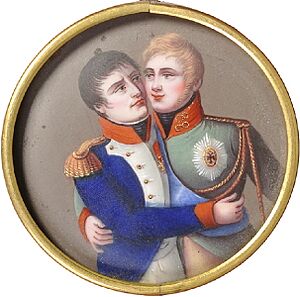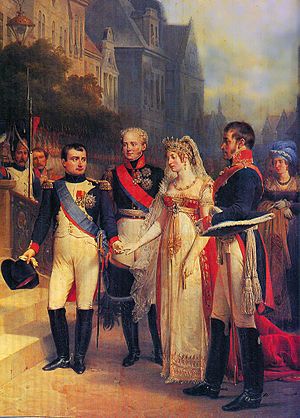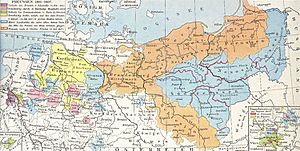Treaties of Tilsit facts for kids
The Treaties of Tilsit were two important agreements signed by the French Emperor Napoleon in July 1807. These treaties happened in the town of Tilsit after Napoleon won a big battle called Friedland.
The first treaty was signed on July 7th between Napoleon and the Russian Emperor Alexander. They met on a special raft in the middle of the Neman River. Two days later, on July 9th, the second treaty was signed with Prussia.
These treaties were very tough on King Frederick William III of Prussia. He had already agreed to stop fighting after Napoleon's army, the Grande Armée, captured Berlin. In Tilsit, Prussia had to give up about half of its land.
From these lands, Napoleon created new states that were friendly to France. These included the Kingdom of Westphalia, the Duchy of Warsaw, and the Free City of Danzig. Other lands were given to states that were already allied with France or to Russia.
With these treaties, Napoleon became very powerful in Central Europe. He also made Russia and the much smaller Prussia become his allies. They joined him against his enemies, the United Kingdom and Sweden. This led to the Anglo-Russian War and the Finnish War. The treaties also allowed France to send its soldiers to fight in the Peninsular War in Spain and Portugal.
Contents
France and Russia Make Peace (July 7)

This treaty officially ended the war between Russia and France. It also started a new alliance between the two powerful empires. This alliance made most of the rest of Europe almost powerless.
France and Russia secretly agreed to help each other if they had problems. France promised to help Russia against the Ottoman Empire. In return, Russia agreed to join the Continental System against the British Empire. The Continental System was Napoleon's plan to stop trade with Britain to weaken it.
Napoleon also convinced Emperor Alexander to join the Anglo-Russian War against Britain. He also pushed Russia to start the Finnish War against Sweden. This was to force Sweden to join the Continental System too.
As part of the deal, Russia agreed to leave Wallachia and Moldavia. Russian forces had taken these areas during an earlier war with the Ottoman Empire. Also, the Ionian Islands and Cattaro (Kotor), which Russian admirals had captured, were given to France. In exchange, Napoleon promised that the Duchy of Oldenburg and some other small states, ruled by the Tsar's German relatives, would remain independent.
France and Prussia Sign a Treaty (July 9)

The treaty with Prussia took away about half of its land. Here are some of the changes:
- Cottbus went to Saxony.
- The land west of the Elbe River became part of the new Kingdom of Westphalia.
- Białystok was given to Russia, creating the Belostok Oblast.
- Most of the Polish lands that Prussia had gained earlier became the Duchy of Warsaw. This new duchy was almost independent.
Prussia also had to reduce its army to only 43,000 soldiers. France also made Prussia pay a huge amount of money as a tribute. This was a very difficult time for Prussia. Many people in Prussia and Russia felt that the treaty was unfair and a great humiliation for their countries.
Some observers noted that the Prussian king was very worried during the treaty talks. It seemed like Napoleon could have made Prussia disappear completely if he wanted to.
Cooperation between Russia and France did not last long. By 1810, the Russian emperor started allowing neutral ships into Russian ports, which went against the Continental System. In 1812, Napoleon's army crossed the Neman River and invaded Russia. This ended any friendship between the two empires.
Prussia's Land and People Losses
Under the Tilsit treaty, Prussia lost more than half of its size. Its land shrunk from about 323,400 square kilometers to about 158,800 square kilometers. Before the treaty, Prussia had about 9.75 million people. After the treaty, only about 4.5 million people remained within its new borders.
The money the state collected also dropped a lot. The lands Prussia lost were very rich and fertile. Most of the land Prussia had gained from earlier divisions of Poland (between 1772 and 1795) was taken away. Saxony gained some provinces. Russia, a stronger former ally, gained land with 200,000 people.
What Happened Next
The War of the Fourth Coalition ended with these treaties. Soon after, the Peninsular War began in November 1807. The War of the Fifth Coalition started in 1809.
The Neman River, where Napoleon and Alexander met, was crossed again in 1812 when France invaded Russia.
After the Napoleonic Wars ended in 1815, many of Prussia's lost lands were given back at the Congress of Vienna.
By signing these treaties, France left Persia and the Ottomans without help. These countries had hoped for France's support against Russia. This led to Persia losing parts of the Caucasus region to Russia, including areas that are now Azerbaijan, Georgia, and Armenia.


